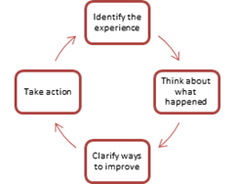 We have plenty of opportunity to fritter away precious time in our places of work. We allow noisy interruptions such as someone knocking on our door and asking, "You got a minute?" to leaving the "sound" on that lets us know that an email has arrived. We also allow silent ones like having little sticky notes on our walls or on our computers and loading our virtual or physical desk top with files, folders and notes. All of these interrupters take us away from our most important priority of the moment. We get further behind and then claim we are "overloaded" with work. Perhaps we fail to realize that every time we are interrupted we lose about 8 minutes of time. Why? Because our mind needs to disengage from what we are doing, deal with the interruption, and then reengage back to the task at hand. What to do: Set aside quiet time to work on your most important items. Some companies have established a policy for their employees not to interrupt their colleagues for the first hour of the day. That time is set aside for them to work on their most important priorities. Failing a company policy, make an appointment with yourself. Guard it just like any other appointment and close your door or put a 'do not disturb' sign on the door or doorway, letting others know that you are busy.. When you have completed that important task you can then remove the 'do not disturb' sign and give the person the attention they deserve. Break the multitasking myth: Many people think they are good at multitasking. The truth is, they are not. It is estimated that only 2% of the population can multitask without loss of productivity or personal energy. This suggests that for the 98% of us who think we can improve our productivity by multitasking, in reality we are reducing it. Studies show that multitasking increases mistakes, slows down productivity by as much as 40%, dampens creativity, increases stress, impacts relationships negatively (think people viewing their cell phone messages while talking to others), and can place us in very dangerous situations (think driving and texting). The answer to multitasking is to focus on one thing at a time, or at least work on similar things consecutively, e.g. pay all bills at one time, even in this case we can only pay one bill at a time Control Cell Phone Usage. Related to multitasking is the misuse of cell phones. Cell phones give us a sense that we can do many things at once, but frankly they can be a huge distraction at work. Consider those who check their phones in meetings, text under the desk, hide their phones in files and folders during a meeting, have their phones on during meal time, maintain personal social networking while employed, and look things up on their cell phone rather than on their employer's computer because it would not be considered appropriate. Cell phones can be a great tool to affirm relationships, improve productivity and be a mini-computer in our hand; but, they also can be great time wasters and a cause for discourtesy and disrespect if we don't manage them properly. The issue here is one of self-discipline where we need to manage cell phone usage rather than allowing it to manage us. Commit time for sleep and rest. We now know that if we are sleep deprived we can expect less productivity and more on the job accidents and mistakes. Improve both your efficiency and effectiveness by getting the appropriate amount of sleep. Delegate but make sure you delegate appropriately. Delegate the "what" and leave the "how" to the delegatee. His or her "how" may actually improve your "how." If so, both you and the members of your team have gained. Of course if the person doesn't know "how" to do the task then coaching is necessary - yet another learning opportunity has presented itself. Turn off the "sound" your email makes when it lands in the inbox. If you use Microsoft Outlook go to your inbox, open the tab "tools." and click options. Under email click "email options" and then click "advanced email options" and unclick "play a sound." Presto another interruption disappears. Commit specific time for your email. Go to your email three or four times a day and at a time when you can respond to the messages. This way you can give due attention to the email rather than being interrupted by it. Set aside time for energy breaks and physical exercise. A vehicle can't run without fuel and must have the right fuel to run. It also needs regular maintenance if it's to operate at top efficiency. So too we need proper food, fluids and physical activity if we expect to function at our best. Learn to say "no, I don't have a minute right now." Ask how important the issue is and if its really important you may have to take the minute. However, I have found that most people who ask "got a minute?" don't have important and urgent matters that require immediate attention. Let them solve the issue themselves and have them report later on how they handled it. You can then praise them for a job well done or turn it into a learning opportunity for them. Work on your priorities and commitments throughout the day. Before you leave the office take 10 to 15 minutes to plan for tomorrow, record your achievements, prioritize and reschedule the tasks left unfinished, and thank those that helped you succeed during the day. Then go home relaxed knowing that you have done your best. When you wake up in the morning you will have a plan of action ready rather then asking yourself that profound question: "What am I suppose to do today?" The Learning: When we apply one or two of these strategies each week they help us to: become self-leaders through focus and self-discipline, take ownership of our responsibilities, be accountable for our actions, improve relationships, become more productive, and respect our own and each other's resource we call time. Thanks for reading Richard P. Fontanie MSW, FCMC Updated from Fontanie Learning Solutions Archives
0 Comments
 Knowledge is the first step to learning but to take that knowledge and do something with it moves us to action and that is the first step to change. Every day we have numerous experiences. Take one of those experiences and identify in some detail what actually happened during that experience. Clarify ways to improve next time; and then make a call to action - do something - act to change a behaviour, add a strategy to overcome an obstacle, or reset priorities to match core values. What ever it is - learn from the experience and develop positive actions to improve. When we use this method of learning we turn every day occurrences into learning opportunities. We make learning continuous when we open our mind to it. A 76 year old can be just as excited about learning something new as a young child. That's why some people say they will never retire. They are always open to new possibilities. What someone thought they knew about themselves or something thirty years ago often pales in light of what they know today. The "knowing" today is often deeper and has many more dimensions than 30 years ago. What to do: At the end of each day take a few moments to identify a positive or a problem experience that happened during that day, reflect on what happened during that experience, clarify ways to improve and then jot down an action for improvement. Put that action in your to do list for the next day.
Remember: “Learning and change are inseparable friends”  Listening is so fundamental to our communication process that we can easily take it for granted. Unless one has extremely limited interaction with people the opportunities for listening abound in the workplace. We need to listen up when a customer is front of us or on the telephone, or when someone comes to us with a problem or a solution, or when we are coaching an employee, or when ______ (you fill in the blank). Every time we encounter an individual our listening antenna needs to go up. There are five levels of listening behaviors with level one being the most comprehensive. Level One: These are the people who listen to understand all the communication signals of the speaker - the tone, emotions, body language and technical elements and even what is being said behind the words. They are the ones who send off the signal: "I am listening intently so that I can walk a mile in your shoes." They are the "empathetic listeners." They are the ones who hold eye contact and listen deeply. Level Two: This listening behavior tends to be more "factual and technical". These people have an ear for factual information, sometimes at the expense of "feelings" or "emotions". They are often called the "objective listeners." Level Three: At level three we have the "selective listeners" or those who listen to confirm their point of view or pick out only what they want to hear. They listen only for the elements of the discussion that they are in agreement with and often miss the whole point of the conversation. Level Four: Here we have the "pretenders." They give the impression they are listening but are often doing something else. For example we can "hear' these people when we are speaking with them over the telephone and they are busy working away on something else; or when we are making a presentation and they are gazing at us like deer caught in the headlights, or texting, or reading their e-mail - all the while nodding their heads to give the impression that they are listening. Level Five: You guessed it - they are the "ignorers." They are not listening at all, which when we really think about it may be an "oxymoron." To listen well we need to develop strong listening habits. Here are the four basic rules for strengthening a good listening habit: 1. Hear what is being said - this means giving undivided attention to the person who is speaking. 2. Understand what we have heard - this means clarifying what is said by asking questions, 3. Interpret our understanding of what was said. -this means the rationalization process of quickly putting into context our understanding of what was said. 4. Recap or paraphrase our understanding of what was said - this means repeating in your own words our understanding of what is said. Remember all communications are perceived but 70% to 90% are screened out or changed by the person who perceives them. If you want to improve your listening habits consider this learning opportunity "Priority Influencing" at http://www.prioritymanagement.com/ and check out an office near you. Author: Richard P. Fontanie MSW. FCMC Updated from the archives of Fontanie Learning Solutions. |
Categories
All
Archives
February 2024
|


 RSS Feed
RSS Feed


